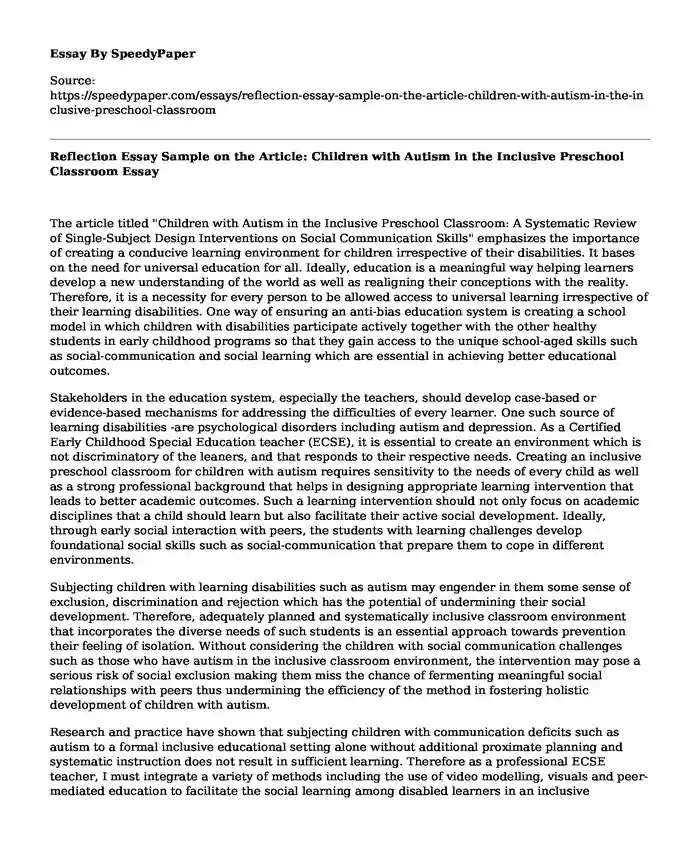
| Type of paper: | Article review |
| Categories: | Education Child development Autism |
| Pages: | 3 |
| Wordcount: | 615 words |
The article titled "Children with Autism in the Inclusive Preschool Classroom: A Systematic Review of Single-Subject Design Interventions on Social Communication Skills" emphasizes the importance of creating a conducive learning environment for children irrespective of their disabilities. It bases on the need for universal education for all. Ideally, education is a meaningful way helping learners develop a new understanding of the world as well as realigning their conceptions with the reality. Therefore, it is a necessity for every person to be allowed access to universal learning irrespective of their learning disabilities. One way of ensuring an anti-bias education system is creating a school model in which children with disabilities participate actively together with the other healthy students in early childhood programs so that they gain access to the unique school-aged skills such as social-communication and social learning which are essential in achieving better educational outcomes.
Stakeholders in the education system, especially the teachers, should develop case-based or evidence-based mechanisms for addressing the difficulties of every learner. One such source of learning disabilities -are psychological disorders including autism and depression. As a Certified Early Childhood Special Education teacher (ECSE), it is essential to create an environment which is not discriminatory of the leaners, and that responds to their respective needs. Creating an inclusive preschool classroom for children with autism requires sensitivity to the needs of every child as well as a strong professional background that helps in designing appropriate learning intervention that leads to better academic outcomes. Such a learning intervention should not only focus on academic disciplines that a child should learn but also facilitate their active social development. Ideally, through early social interaction with peers, the students with learning challenges develop foundational social skills such as social-communication that prepare them to cope in different environments.
Subjecting children with learning disabilities such as autism may engender in them some sense of exclusion, discrimination and rejection which has the potential of undermining their social development. Therefore, adequately planned and systematically inclusive classroom environment that incorporates the diverse needs of such students is an essential approach towards prevention their feeling of isolation. Without considering the children with social communication challenges such as those who have autism in the inclusive classroom environment, the intervention may pose a serious risk of social exclusion making them miss the chance of fermenting meaningful social relationships with peers thus undermining the efficiency of the method in fostering holistic development of children with autism.
Research and practice have shown that subjecting children with communication deficits such as autism to a formal inclusive educational setting alone without additional proximate planning and systematic instruction does not result in sufficient learning. Therefore as a professional ECSE teacher, I must integrate a variety of methods including the use of video modelling, visuals and peer-mediated education to facilitate the social learning among disabled learners in an inclusive classroom environment. In essence, I must concentrate on in-depth studies to identify the approaches that have proven effective in inclusive learning settings. When such interventions are made a routine, they nurture a variety of desired learning behaviours in the learners. Through the use of visuals such as small cards with different colours, drawings or photographs, I will be able to break down the sophisticated knowledge that would otherwise prove challenging for a child with autism. It has the potential of simplifying complicated social skills such as greeting a peer into manageable behaviours that improve the process of learning.
Reference
Hansen, S. G., Blakely, A. W., Dolata, J. K., Raulston, T., & Machalicek, W. (2014). Children With Autism in the inclusive preschool classroom: A systematic review of single-subject Design interventions on social communication skills. Review Journal of Autism and Developmental Disorders, 1(3), 192-206.
Cite this page
Reflection Essay Sample on the Article: Children with Autism in the Inclusive Preschool Classroom. (2022, Apr 19). Retrieved from https://speedypaper.com/essays/reflection-essay-sample-on-the-article-children-with-autism-in-the-inclusive-preschool-classroom
Request Removal
If you are the original author of this essay and no longer wish to have it published on the SpeedyPaper website, please click below to request its removal:
- Leadership That Gets Results - Book Review Essay Sample
- Legalization of Marijuana Essay Sample for Everyone
- Free Essay on the Prima Cinema - Investment in the Movie Theatre
- Essay Sample Dedicated to Euthanasia Decriminalization
- Essay Sample: How Nurses Assist Newborn Babies in the Neonatal Intensive Care Unit
- Essay Example on the Globalization of the English Premier League
- Essay Sample on Analyze the Different Aspects of Medicare Programs
Popular categories




